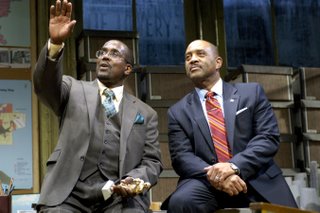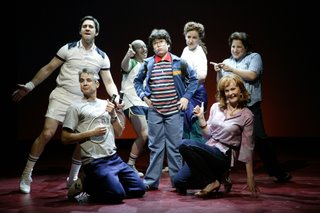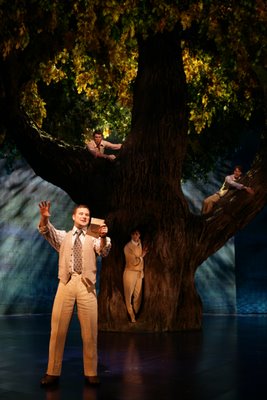 $50 Buys two gallons of scenic paint. Our paint shop uses an average of 40 gallons per show, over 300 gallons in a season. Left over paint is mixed and treated with flame proofing compounds to be used as a fire retardant back paint on our scenery to meet fire code and help insure the safety of our staff and patrons. In this picture you can see the scenery representing the Baths created for our 2005 production of The Rivals. The dimension seen on this exterior is 30% real, 70% paint technique. Photo: T. Charles Erickson
$50 Buys two gallons of scenic paint. Our paint shop uses an average of 40 gallons per show, over 300 gallons in a season. Left over paint is mixed and treated with flame proofing compounds to be used as a fire retardant back paint on our scenery to meet fire code and help insure the safety of our staff and patrons. In this picture you can see the scenery representing the Baths created for our 2005 production of The Rivals. The dimension seen on this exterior is 30% real, 70% paint technique. Photo: T. Charles Erickson $100 Buys some beautiful wool fabric imported from England from which to tailor a man's suit. For the entire suit, that's about three yards - then we add linings, interlinings, buttons, zippers, etc. Not to mention the tailoring itself! Some of that is done in house, some is sent out. We purchase “stock” fabrics, such as linings, muslins, and the above wool cloth each season in bulk, often from overseas, for the quality and reasonable cost. Pictured here are the sharply attired Roosevelt Hicks (James A. Williams) and Harmond Wilks (Hassan El-Amin) in our Fall 2006 production of August Wilson's Radio Golf. Photo: Eric Antoniou.
$100 Buys some beautiful wool fabric imported from England from which to tailor a man's suit. For the entire suit, that's about three yards - then we add linings, interlinings, buttons, zippers, etc. Not to mention the tailoring itself! Some of that is done in house, some is sent out. We purchase “stock” fabrics, such as linings, muslins, and the above wool cloth each season in bulk, often from overseas, for the quality and reasonable cost. Pictured here are the sharply attired Roosevelt Hicks (James A. Williams) and Harmond Wilks (Hassan El-Amin) in our Fall 2006 production of August Wilson's Radio Golf. Photo: Eric Antoniou.$175 Condoms for a musical. Yup, condoms. There seems to be something in the water here, with 10% of the production staff this year welcoming a newborn family member, but that has nothing to do with our support of the Trojans.
 Musicals often require wireless microphones which consist of two parts; the first is the mic, which is often placed in the actor’s hair or wig. The second is the transmitter, which is hidden on the performer in any number of locations, such as the small of the back, inner thigh, or even under a wig. You can imagine these locations can get moist and steamy as we have not yet developed actors who don’t sweat. Electronics and moisture don’t mix well so to protect the actor and equipment the transmitter is protected by an (un-lubricated) condom. One per actor per show. Shown here is the full cast of the Huntington Theatre Company's 2005 production of Falsettos. Photo: T. Charles Erickson
Musicals often require wireless microphones which consist of two parts; the first is the mic, which is often placed in the actor’s hair or wig. The second is the transmitter, which is hidden on the performer in any number of locations, such as the small of the back, inner thigh, or even under a wig. You can imagine these locations can get moist and steamy as we have not yet developed actors who don’t sweat. Electronics and moisture don’t mix well so to protect the actor and equipment the transmitter is protected by an (un-lubricated) condom. One per actor per show. Shown here is the full cast of the Huntington Theatre Company's 2005 production of Falsettos. Photo: T. Charles Erickson $350 Gets us 18 sheets of ¼” MDF, or 19 pieces of 24’ 1” tube steel, or 650 board feet of 1”x 4 “pine, or twenty four 30’ tape measures, or six “kegs” of screws and fasteners. Materials for our scenery can range from $14,000 for a small show such as 2006's The Road Home to $50,000 for a large show such as Love's Labour's Lost, with that amazing tree. A musical which can included many computer controlled winches that speedily moved scenery on and off stage can easily top $100,000, illustrating one of the reasons we don't do them that often. In this photo Dumaine (Eric Anderson) proclaims his love thru poetry as his compatriots peer down from a tree in the our 2006 production of Shakespeare’s comedy, Love’s Labour’s Lost, directed by Nicholas Martin. Photo: © T. Charles Erickson.
$350 Gets us 18 sheets of ¼” MDF, or 19 pieces of 24’ 1” tube steel, or 650 board feet of 1”x 4 “pine, or twenty four 30’ tape measures, or six “kegs” of screws and fasteners. Materials for our scenery can range from $14,000 for a small show such as 2006's The Road Home to $50,000 for a large show such as Love's Labour's Lost, with that amazing tree. A musical which can included many computer controlled winches that speedily moved scenery on and off stage can easily top $100,000, illustrating one of the reasons we don't do them that often. In this photo Dumaine (Eric Anderson) proclaims his love thru poetry as his compatriots peer down from a tree in the our 2006 production of Shakespeare’s comedy, Love’s Labour’s Lost, directed by Nicholas Martin. Photo: © T. Charles Erickson.I might get another post out this week as it will be pretty quiet around here tomorrow, but if not I'll give my Thanksgiving nod now. Thank you to my staff and co-workers for making this job such a pleasure. Most of the time. Really.

No comments:
Post a Comment